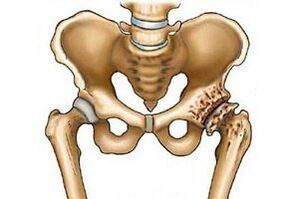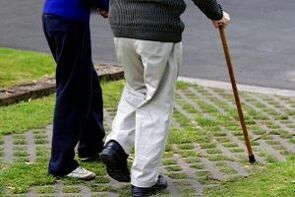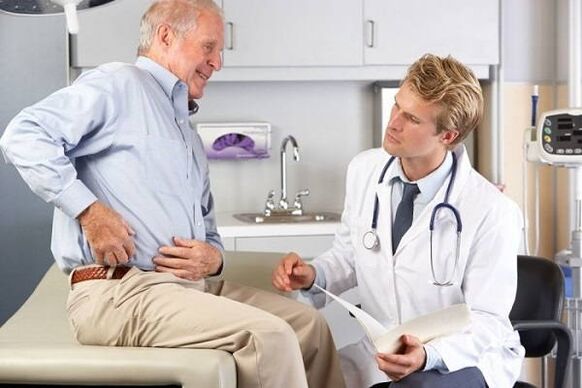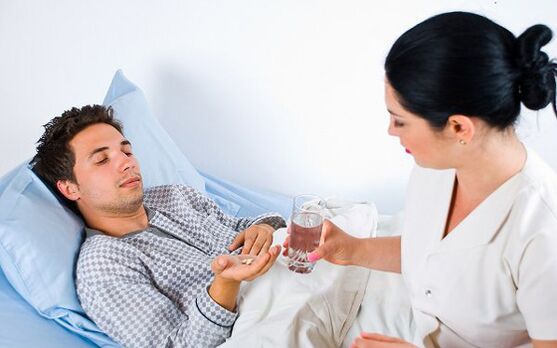One of the most common pathologies of the musculoskeletal system is hip deformity. The progressive process affects the inner cartilage, destroying bone and connective tissue. Both one mobile connection and both are affected. The second name of the disease is coxarthrosis, which usually manifests in women after the age of 40.
The reason for the development of the disease
The disease is not inherited, but the presence of genetic features of tissues and bones can stimulate development and transmit the disease from parents to children. Osteoarthritis of the hip is considered an age-related problem, which is caused by the aging of the body. There are cases where the process of destruction of the hip joint begins in young people.
The main causes of hip arthropathy include pathologies that provoke the pathological process:
- tissue trauma (femur neck fracture, infection);
- intense physical activity (sports, weightlifting);
- joint infection (arthritis);
- femoral head death;
- fat;
- endocrine diseases such as diabetes mellitus, metabolic disorders;
- scoliosis.
The hip joint is destroyed under the influence of various factors. Therefore, people with genetic predisposition, overweight, heart disease are at risk of disease.
Types of diseases

There are two types of hip osteoarthritis:
- Primary or idiopathic. Developed after 50 years. Differs in symmetrical lesions of the joint. The course was disappointing, it was difficult to determine the cause of the destruction of the pelvic joints.
- Middle School. That is characteristic of youth, the motivation is different pathologies. The failure of a joint is characteristic: left or right. The process is slow, if you take the medicine as prescribed by your doctor and follow the recommendations, the disease will respond well to treatment.
The disease leads to the complete destruction of the joint.
Degree of coxarthrosis and characteristic symptoms
The process of destruction of the hip joint is gradual, each of the three stages is accompanied by specific symptoms:
- Initial stage. Grade 1 hip osteoarthritis accompanied by signs:
- intermittent hip pain due to exercise, pelvic tension;
- discomfort in the groin;
- lack of movement restrictions;
- slight narrowing of joint space.

- Grade 2 disease. There is an exacerbation, in the pelvic region, the local temperature rises. Pain at rest and with exertion. The development of grade 2 hip osteoarthritis is accompanied by the following symptoms:
- infiltrative and severe pain syndrome, especially at night;
- characteristic "beginning" pain that accompanies movements after rest;
- limited mobility, which leads to cartilage destruction and inflammation;
- the appearance of a limp;
- difficulty in flexing the feet, flexing the limbs;
- muscle atrophy, in which the affected leg looks flabby;
- Joint space is narrowed, there is bone compression on X-ray.
- Finally, stage 3. She talks about irreversible processes. It is accompanied by the following symptoms:
- joints are constantly painful, the general condition worsens;
- change in the size of the lower extremities;
- limping while walking;
- complete immobilization of the joint, which causes obstruction of the pelvic joint;
- Without the cartilage layer, the bone surfaces are interconnected.
Diagnosis of Osteoarthritis

The appearance of initial symptoms does not push a person to the clinic, and he prefers self-treatment. However, osteoarthritis of the hip requires urgent medical attention and prompt diagnosis. At consultations, the presence of arthritis, which leads to a complication in the form of coxarthrosis, is denied or confirmed. To do this, contact specialists such as:
- therapist;
- neurologist;
- rheumatologist;
- orthopedist (surgeon).
The examination is very complex, therefore, all diagnostic measures are carried out in two directions:
- Clinical diagnosis:
- examination (look for pain);
- bending, straightening, rotating the limb;
- asymmetry of the legs;
- pain to palpation.
- Tool test:
- X-ray:
- CT;
- Magnetic Resonance;
- supersonic;
- aspirate fluid from the joint space (if necessary).
What treatment is needed?

The goal of all therapeutic procedures is to relieve pain and improve joint mobility. Depending on the extent of the damage, hip osteoarthritis is treated with a variety of methods.
At the initial stage of development, conservative treatment is used, at stage 2, the development of pathology stops, and grade 3 arthropathy can be cured by radical methods.
After confirming the diagnosis of hip osteoarthritis, the doctor recommends a series of treatment measures, including pharmaceutical treatment and physical therapy procedures. Treatment is aimed at eliminating the symptoms of pain and inflammation, stopping the processes. In severe cases, surgical treatment with prostheses is used.
conservative method
With coxarthrosis in the 1st and 2nd degree of the hip joint, an integrative approach can help: medication, therapeutic massage, gymnastics, chiropractic. To treat joint disease in non-surgical ways means to prevent surgical intervention. First of all, the doctor prescribes pain medication to relieve the symptoms of ongoing pain that accompanies grade 2 hip osteoarthritis.
medicine
Drug therapy includes the use of the drugs presented in the table:
| Coporation, group | therapeutic action |
|---|---|
| Anti-inflammatory (non-steroidal) | Symptomatic, helps to numb the limbs and has anti-inflammatory effect |
| steroid hormones | They are used in cases where there are no results when using non-steroidal drugs, which help reduce pain and inflammation. |
| Chondroprotectors | Restore the structure of cartilage tissue, improve the production of joint fluid |
| Hyaluronic Acid | Injected into joints to lubricate joint surfaces |
| Muscle relaxants | Decreased muscle tone, improved blood flow through vessels |
physical therapy

With coxarthrosis, massage, therapeutic exercise, electrophoresis, cryotherapy, and many other therapies are all helpful. Let's take a closer look at the main ones:
- Exercise therapy is the basis of therapy. It will help locate the disease in any part of the body. A special system of exercises will strengthen muscles, eliminate discomfort during training.
- Manual massage and therapy - passive muscle recovery. Especially useful in the first stage of pathological development.
- Phonophoresis enhances the effect of drugs by ultrasound. If you apply the medicine to the TBS area and apply ultrasound waves, the medicine will quickly penetrate the skin.
- General traction. The use of a special apparatus will increase the intra-articular distance.
- Diet. Helps reduce pressure on joints. Properly selected products improve health, but dietary nutrition is not included in the primary treatment.
folk remedies

At home, traditional medicine methods come to the rescue. The patient can be warmed and applied, which helps to reduce inflammation and reduce swelling.
The use of a gauze with honey, aloe vera juice, sea salt provides a large amount of blood to the inflamed area, which improves blood circulation in it. Folk remedies are part of the initial complex treatment, as well as 2-3 degrees of pathology.
Severe injuries are treated with surgery. The diseased joint is replaced with a metal joint.
Prevention of hip osteoarthritis
Prevention of hip osteoarthritis is not difficult. You must adhere to the following recommendations:
- exclude a sedentary lifestyle;
- play sports;
- body weight monitoring;
- refuse bad habits;
- promptly correct congenital and acquired malformations in the hip joint.
Coxarthrosis is very dangerous, so prevention after 40 years is important for everyone. But there is also a risk group, which includes athletes and people with a genetic predisposition. When similar symptoms appear, it is important to immediately consult a doctor. Early diagnosis will allow you to get effective treatment and avoid surgery.







































